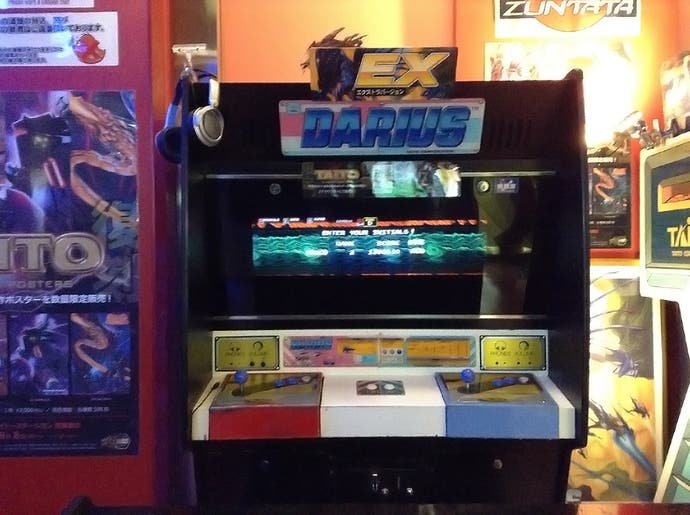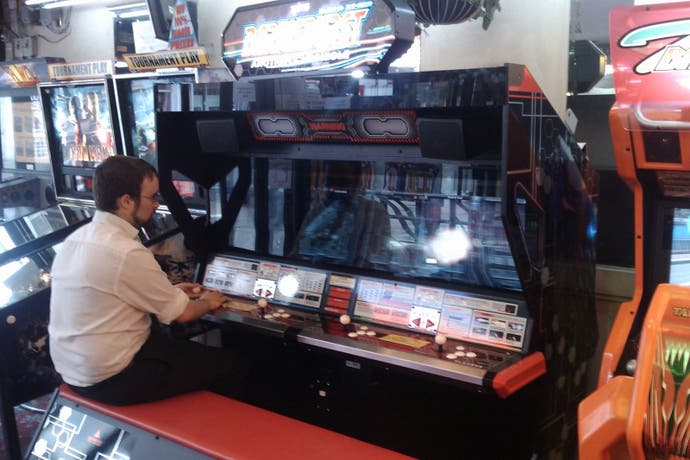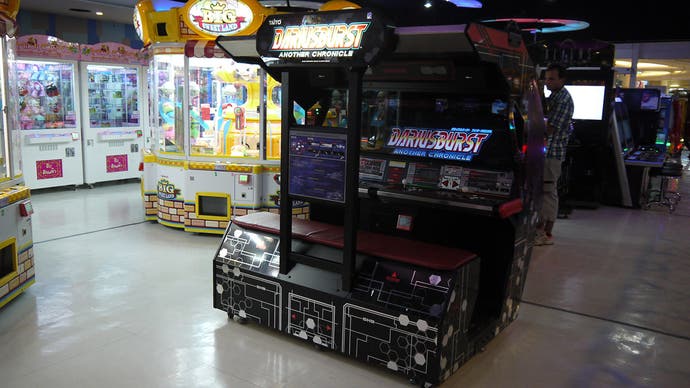Dariusburst Another Chronicle is still the ultimate trip
I've always wanted a thing called tuna sashimi.
It's July 2011 and, overlooking Tottenham Court Road from an elevated position, Café Nero's leather armchairs bask in rare afternoon sunshine. Through the windows, beyond the crawling red double-deckers and people pursuing invisible paths to the workplace, you can see Casino amusements, its tubular neon sign a relic of 1980s tech, beaming against a grubby yellow backboard.
A forum announcement that Dariusburst: Another Chronicle had entered the building, eventually corroborated with photographic proof, triggered an Olympian style citywide sprint for the Northern Line. Goodge Street the destination, shooting-game groupies armed with pockets full of change went diving over ticket barriers, through rapidly closing train carriage doors, and headlong into sidewalk negotiations.
Sandwiched between a Scientology centre and a Computer Exchange, Casino's upstairs entrance once greeted you with a carpet the same age as the outside signage, a couple of pinball machines and a Time Crisis 3 line-up. But then, wedged between Battle Gear and an Avatar Pinball machine, stood the comparatively ethereal Dariusburst, a shiny piece of Japan and a long way from home. Previously headed to the Trocadero's Funland before it got the kiss of death, Casino owner John Sturges prudently intercepted and rerouted.

The first new instalment in Taito's shooting game series since 1997's G-Darius, Darius Burst was a 2009 Japan-only PSP game by Pyramid, developer of the Patapon series, that later received a revised iOS port. In 2010 Taito migrated it to arcades under the suffix Another Chronicle, featuring re-engineered stage structures, screen dimensions, mechanics, difficulty, audio and bosses.
More powerful than its handheld counterpart on every possible front, it was both a nod to and an evolution of Taito's original 1986 three-screen Darius cabinet (now beautifully preserved in Tokyo's Kawasaki Warehouse). Enhancing the shooting game experience just as it did 30 years prior, the enormous taikan houses two 32-inch monitors, an array of bass heavy speakers, and flashing overhead lights beneath its enveloping hood. With vibrating body-sonic seats, complimentary headphone inputs and a host of futuristic ergonomic embellishments, the four-player crimson lacquer control panel is primed for take off.
As a coin rolls into the slot and the speakers sound out, you enter a widescreen bay of starry space and shiny pyrotechnics. As is typical for Darius, a choice of avenues dictate the difficulty of the game, allowing you to vary your route after each boss defeat. Reworked for credit-based gratuities, the PSP version's first two mandatory stages have been excised so you only need to play three for a clear. To compensate, the difficulty has been appropriately rebalanced for a sterner overall challenge. There are a handful of original sections and fresh soundtrack additions, while bosses have greater resilience and some fierce new attack patterns.
Set a century after Darius 2, according to Taito's chronology, a fourth craft known as Formula joins the three Silver Hawk fighters from the PSP game, and the ships now have the ability to shoot in both directions - a feature that dramatically alters the dynamic from that of the handheld.
Characterised by hardy gunships, claustrophobic scenery and incoming destructible obstacles, its twelve stages are varied in their breadth and depth. Graphically it's even tempered and rather beautiful with it; and while series fans may find its largely deep space setting less inspired than the likes of Darius Gaiden, it's still an impressive ride through star-studded interplanetary vistas, glowing suns and luminescent slip-space tunnels.
At the game's core is the Burst Cannon, a sizeable laser that makes all the difference against the Belser army's aquatic ranks and devastating space crustaceans. Regulated by a small yellow meter, letting rip with the cannon is short-lived; but detaching it from your craft with a double-tap of the button allows it to fire independently as you move around the screen, last for an extended period, and simultaneously recharge as it destroys enemies and select incoming bullets. In this state it can be angled and locked at a degree of your choosing by briefly depressing the fire button, and used tactically in offensive and defensive fashions. The arcade's expanded play area allows you to experiment with the cannon's 360 degree capabilities far more than was possible in the handheld version, opening up myriad options for approach.

As the challenge becomes more intricate, so do the opportunities for exploiting the Burst Cannon's potential. Where you'll initially expend it in quick bursts against larger adversaries, its versatility eventually becomes a point of focus, especially as a shield against hails of consumable bullets and rogue meteor storms. Perhaps the most thrilling - and dangerous - of its uses, is initiating a Burst Cannon duel: a game of chicken that requires you to engage the weapon point blank just as a boss fires its primary laser. It's white-knuckle terrifying to wait for a break in the attack index of an adversary a thousand times your size - signified by the pre-warning blink of its laser muzzle - only to then rush in nose-to-nose; but it's an absolutely formidable technique if timed right, boosting the power of your craft significantly enough to cut certain battles in half. Miss the timing by a fraction, however, and you're only a few shields away from death.
Accompanying the regular game is Novice Mode, offering unlimited lives but no access to the scoreboard, and Chronicle Mode, in which you conquer star systems by tackling a grid of assorted challenges. Similar to the PSP's Mission Mode, these may involve finishing two bespoke stages back-to-back, tackling boss rushes, being restricted to a specific ship, having limited weaponry, or relying on a single life. The cabinet dutifully records the names of the parties that aided the effort and the date their victories occurred, encouraging gaming communities to work toward a common goal. This refreshingly social twist is bolstered by fascinating longevity. With Chronicle Mode's wealth of challenges featuring a purported 1347 areas to clear under varying conditions, it will take an arcade kinship months to liberate the cabinet. Even then, the scope for new content is only a fibre optic telephone call away, Taito having already released several upgrades in Japan via their online Netsys operation.
Most glorious of Dariusburst Another Chronicle's features is its four-player mode - a first in traditional shooting-game history. Much more than a gimmick, joining three friends in a campaign against the Belser horde is as fulfilling an experience as one could wish for. Beyond chasing power-ups in conga-line fashion, sharing life stocks and committing to various roles, the tactical opportunities for combined Burst Cannon usage are seemingly bottomless. With rank actively cranking up bullet count and boss aggression according to the size of your fleet, it positively simmers when all four players have an agreed strategy, protecting each other and combining cannon blasts for a massive power offensive.
Although the machine's design, presence, and wealth of features are impossible to replicate in the palm of one's hand, laying out its mechanical assembly is merely skimming the surface. More important is how the components come together to create an unparalleled experience. Rather than crudely dump the PSP game into a cabinet, it's been remodelled into a timeless tribute to the arcade, where sitting under the hood is as much a fairground ride as its beguiling housing suggests.

The Darius series' seafood flavour and esoteric charm, characteristic oceanic monsters and subtle aesthetic mystery are essentials to its personality. Eschewing the usual shooting game straight line, its branching paths entice with new depths of discovery and unpredictable challenge. Likewise, Dariusburst Another Chronicle's marine themed operatic space war is consistently dream-like, a slow ebb through a cosmos punctuated by dwarfing conflicts and organic schools of mechanised fish. The overhead lights pulse as you enter protracted battles, navigate mobile scenery, pit laser against laser, and are consumed by teeth-rattling explosions that offer a moment's respite before charging you down star tunnels to new corners of the universe.
Its soundtrack is a cinematic eargasm on a level Taito's in-house Zuntata - a musical outfit founded in 1987 by Hisayoshi Ogura - haven't achieved since the likes of Darius Gaiden and Layer Section. Shohei Tsuchiya's composition is similar in tone to the eclectic work of Kenji Kawai: a haunting contemporary fusion of operatic choirs, pounding beats and traditional Japanese instruments. True to series form, it lends the game a potent artistry. Photosynthesis Suite no.3 is little short of stunning, and the successful experimentation with offbeat sounds and sea life samples is beautifully harmonised in Photosynthesis Suite no.5's weird and wonderful mix of vocals and commanding drums. The selection of new tracks are arguably even better than the PSP compilation, making superb use of the cabinet's thundering bass.
While Darius bosses are often the centrepiece and the preceding stage a mere preface for power-upping, here these engagements have become a demonstration of grand hardware utilisation. Expanded, upsized, and amplified to take advantage of the mammoth display, when the background scenery transitions into a murky subspace pocket you can steel yourself for a clash that often constitute two-thirds of a stage's length. As the music fades and the adrenaline ignites to the deafening warble of the warning sign - seat rumbling as your Silver Hawk fighter peels into the foreground - Iron Fossil, all 6,935 tonnes of him, roars into the screen bristling with ceramic armoured scales. Ancient Barrage spits a laser deluge from his shell that requires a Burst Cannon bridge to cross to the opposite side of the screen, and Hyper Jaw gets a set of laser armament upgrades slamming on mid-fight. Violent Ruler, a bespoke boss, chugs curtain fire and missiles, while Brightly Stare cuts an ominous beam through the black womb of space.
Nothing, however, compares to Great Thing, a returning final boss and mecha sperm whale of truly epic proportions. His screen-filling entrance is dizzying, breathtaking, awe-inspiring: of a magnitude that puts your heart firmly in your mouth. A near ten-minute conflict of hell and elation, the music drives out grinding beats to a tempo fuelled by a network of lasers. Win or lose, it's a face-off that has to be experienced.

It's inspiring to see one of gaming's oldest genres revisited so passionately. In itself representative of some small rebirth of arcade culture, Dariusburst Another Chronicle proved a surprise success for Taito, making its way to various locations around Asia and Europe. In 2012 it received an update, retooled for experts with twelve new stages, four new ships, more Chronicle Mode missions, and fresh opportunities for scoring.
In more recent news, rumour of a PlayStation 4 port surfaced on shmups.org's forum, Taito as yet having made any comment regarding its legitimacy. Should it ever arrive in the home, one hopes there's an option to couple two monitors together to replicate the arcade's Guinness World Record holding 32:9 aspect ratio.
And as for Casino, central London's stronghold for the dedicated arcade gamer? Sadly it closed its doors in February 2013 after nearly 30 years in business. It was a place where, for the fervent hardcore gamer, the magic happened when you followed the disco mirrors downstairs into a carpeted dungeon lined with arcade machines. The Electrocoin booths and stand-up cabinets may have been ancient, but the ramshackle environment was part of the charm, and as such hosted a small community of devoted patrons. They existed in pocketed groups, a herd mentality allied either to the fighting game, shooting game, or old-school retro classic. In occupying the same grazing space, intermingling occurred as a matter of course, whether bumming smokes on the doorstep, venturing next door for fried chicken intermissions, or dipping toes in genres unfamiliar.
This sociability is what the arcade does best, and in its absence, what we as gamers have lost. So if you do find a Dariusburst cabinet in the wild, grab the three nearest passers by and drag them under the hood for a go. If they didn't understand the relevance of the arcade beforehand, they most certainly will after experiencing Taito's homage to a once flourishing industry.
In memory of Casino arcade, which ceased operations after thirty years in business. Thanks for all the good times.

